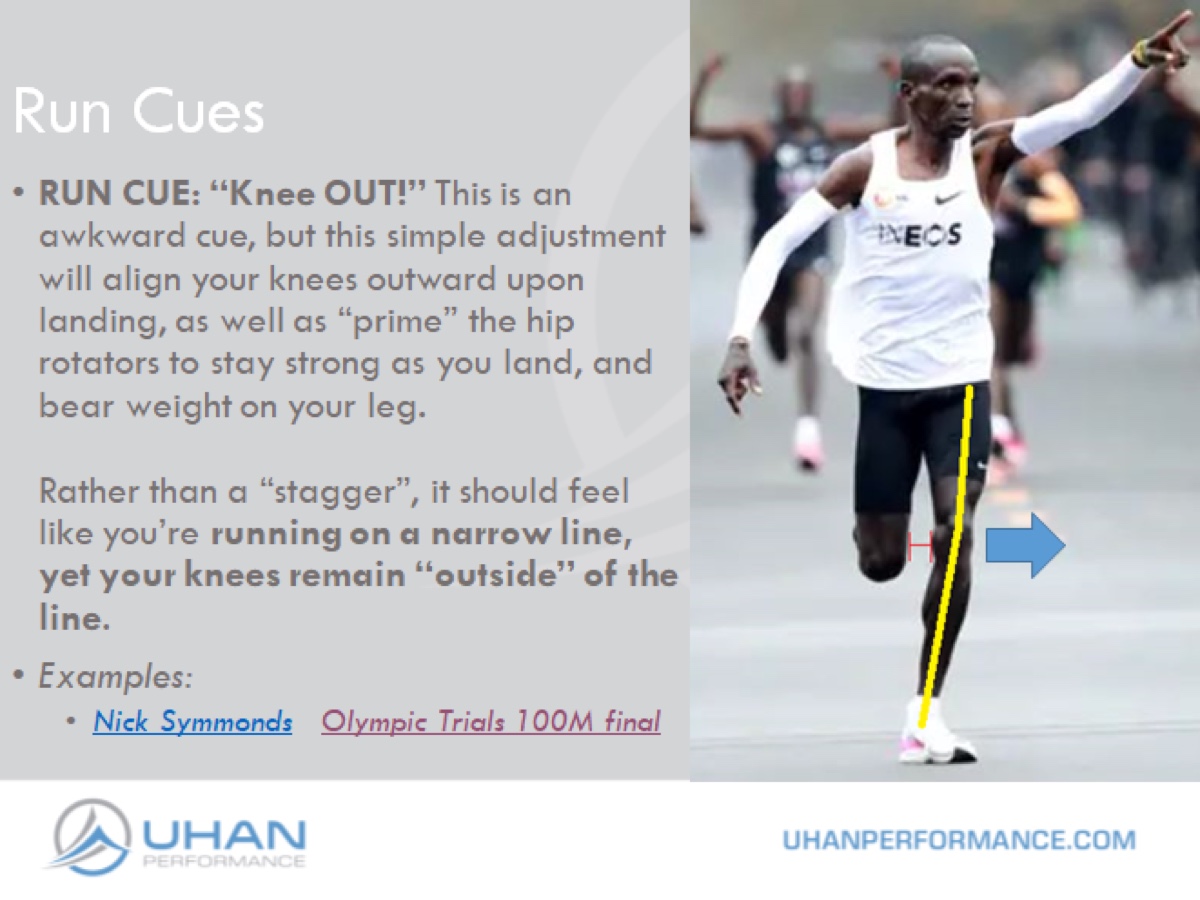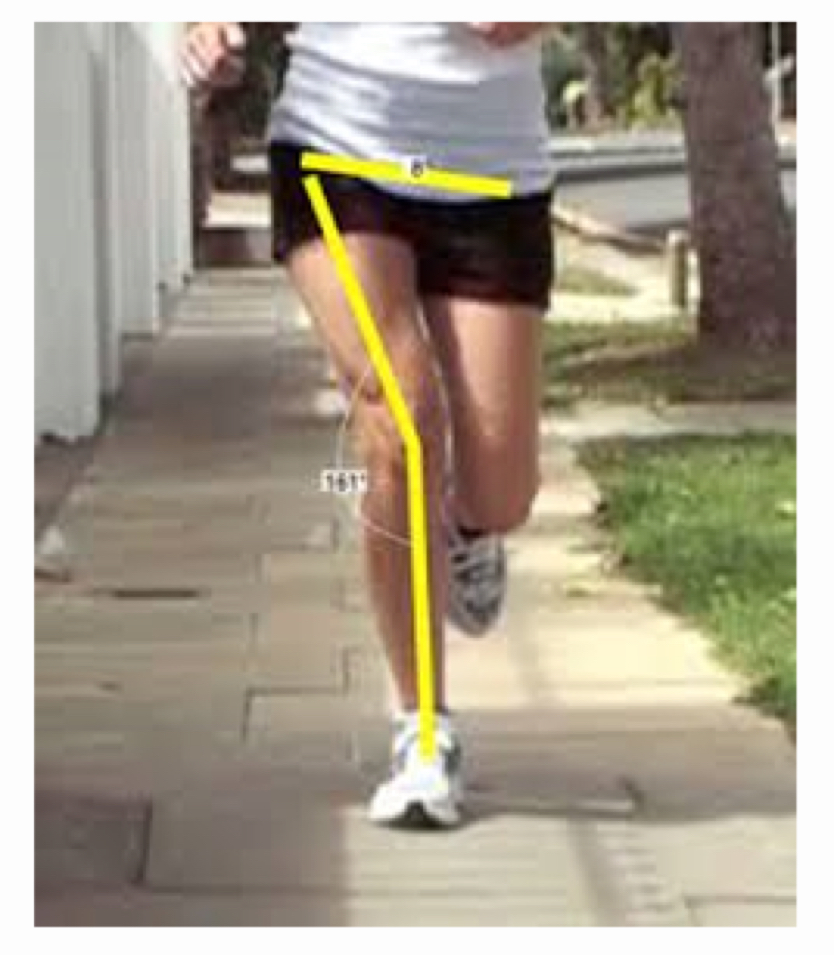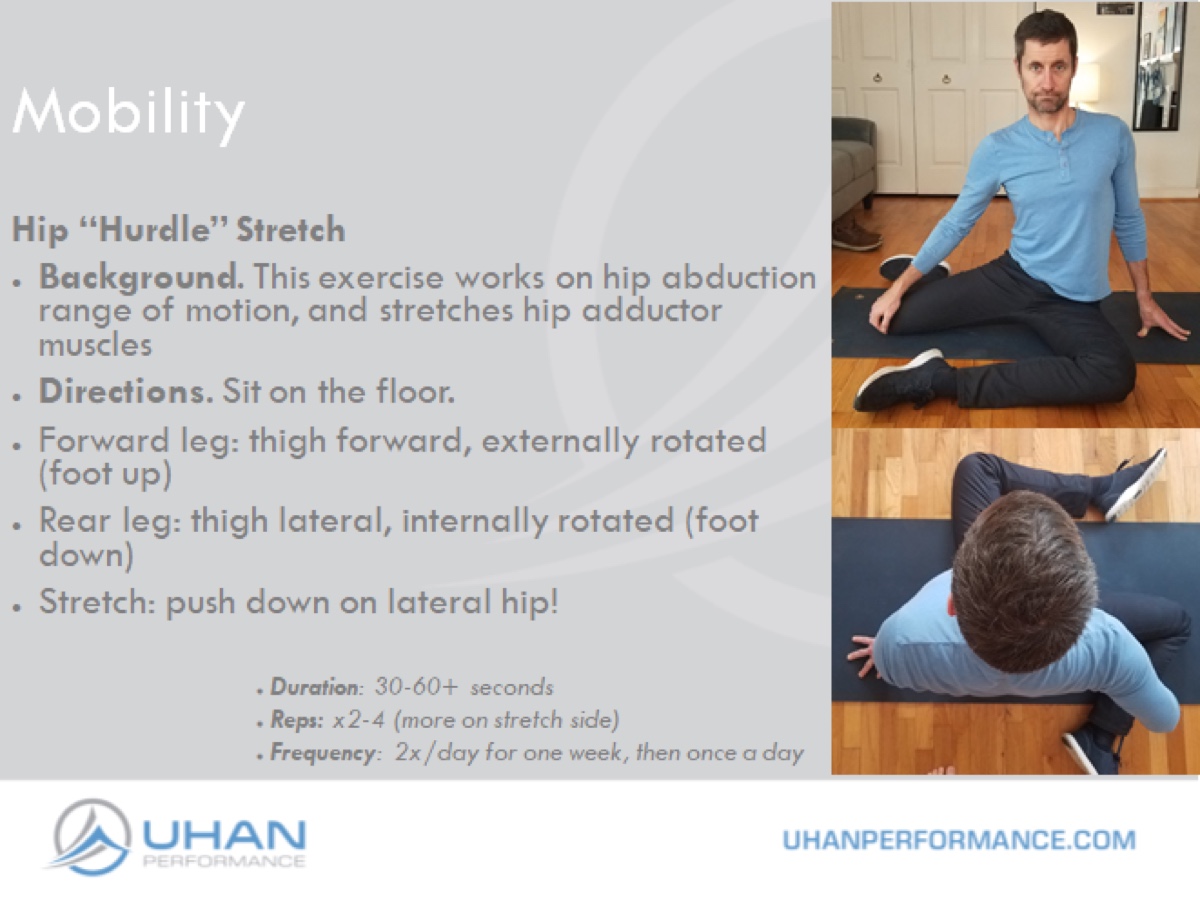This is the second of a two-part series on knee alignment in running. Be sure to check out Part One. Neutral knee alignment is important for two reasons:
- It limits stress upon landing; and
- It promotes an efficient, strong push-off.
As the midpoint of the leg, the knee plays a huge role in efficiency in how we land and push off. Deficits of both its position and stability can create both excessive aches and pains and rob us of precious propulsive energy.
The Goal is a Straight-But-Angled Line
Efficient stance-leg alignment places the knee in a straight line between the hip and the foot. In the frontal view of running, with the foot landing directly beneath the body, neutral alignment of the leg creates a straight-but-angled line from the ground to the hip joint on the lateral pelvis:

Frontal-plane running with a knee-out stance in Eliud Kipchoge. Image created by Joe Uhan, photo from Newscientist.com/article/2219769-eliud-kipchoges-sub-2-hour-marathon-may-herald-even-faster-times/.
When considering only the foot in single-leg stance, it’s easy to assume that the alignment is okay when the knee is simply directly above the foot. However, because of the lateral position of the pelvis, the knee must be relatively out or lateral to the foot in order to truly be in line with the hip. Anything less than that creates a valgus or inward-bending alignment of the leg at the knee:

Frontal-plane running with a valgus or inward-bending alignment in a runner. Photo: Tokinesiology.ca/blog/it-band-syndrome-causes-and-treatment
Thus, most runners would benefit from having a knee-out focus to ensure that the knee is sufficiently lateral to maintain linear hip-knee-foot alignment.
Real-Life Stride Analysis: The Jim Walmsley Gold Standard
To get a better idea of knee-out alignment, let’s look at this kind of mechanics on one of ultrarunning and trail running’s greatest talents, Jim Walmsley. Among his many talents, I believe one of his greatest is his stride efficiency (and his ability to maintain it, deep into fast and long ultramarathons). Below is a real-time video breakdown and discussion of his strengths (and very minor weaknesses):
Real-Life Stride Analysis: Knee Valgus and Crossover/Narrow Landing
As discussed Part One, when landing stability is deficient, two compensations can be seen:
- Knee Buckling-In – This is classic knee valgus, where the knee lands or migrates medially, with respect to the hip and foot.
- Crossover/Narrow Landing – To avoid buckling in, another compensation is to land excessively medially. This often results in a foot stride that crosses midline.
Below is a video breakdown that demonstrates both compensations in one of my clients and former student-athletes. She is a former cross-country runner turned elite-level sprinter:
In contrast, here is a short clip showing the frontal-plane knee alignment, stride width, and knee “daylight” of elite American sprinters:
Training Knee Alignment
Here are a few strategies to help promote knee-out alignment in running:
Mobility
General hip mobility is crucial to be able to properly align the leg at landing, push-off, and swing-through. One overlooked muscle group in runner hip flexibility is the adductors: the muscles of the medial thigh and hip (and fodder for a future column!) For now, here is one of my favorite running-specific adductor stretches, the adductor hurdler stretch:
Tight adductors can result from–and subsequently perpetuate–both a knee-in and excessively narrow landing. Stretch ‘em out!
Strength
Single-leg strength and stability are the foundation of efficient knee alignment and strong stability. My two favorites are:
- The Ice Skater (full article here); and
- Symmetrical Step-Up.
Drills
Hopping drills in a knee-out alignment–especially when adding some verticality by jumping up and down small heights–is the best practice for improving alignment with uphill and downhill running, as well as stability on mountainous terrain. Both single- and double-leg hopping should be done with utmost knee-out focus and, if possible, with banded resistance around the knees.
Below are my three favorite hopping drills:
- Single leg crossover hop;
- 100-Up (full article here); and
- Plyometric box jumps.
Knee-Out Running
Finally, having a knee-out running alignment is as easy as… running with your knee out! And while this may seem impossible, and feel even more impossibly awkward, it is not only effective but, over time, begins to feel stronger, more comfortable, and faster. My favorite practice strategy is to go to a track, or to find a long sidewalk or pavement seam. Once there, you simply:
- Run on the line (not straddling it, just on it, without crossing over); and
- Maintain the knees outside of it.
Here is a video of me demonstrating what this practice looks like:
Conclusion
It took me a long time–as runner, coach, and physiotherapist–to accept and adopt a knee-out cue as a viable strategy for efficient running. Yet, it has turned out to be one of the most potent of strategies for both decreasing aches, pains, and injuries and improving stability, top-end speed, and endurance. I hope you’ll give it a close look and a good try.
Call for Comments
- Did you use Part One of this series to help determine your running knee alignment?
- Have you received a diagnosis of a misaligned knee in the past?
- What kinds of exercises do you do to help create a neutral and knee-out alignment when you run?

